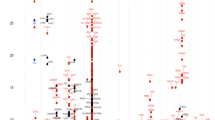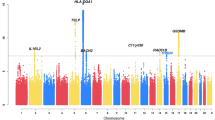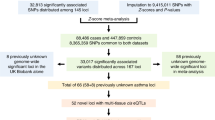Abstract
G-protein-coupled receptor for asthma susceptibility (GPRA or GPR154) was identified as an asthma and atopy candidate gene by positional cloning. Some subsequent studies suggest associations of GPRA single nucleotide polymorphisms (SNPs) and haplotypes with asthma or atopy susceptibility. However, the associated SNPs or haplotypes vary among studies. The role of GPRA genetic variation in asthma and atopy remains unsolved. Published data on GRPA variants and asthma come exclusively from Caucasian and Asian populations. We examined whether GPRA SNPs and haplotypes are associated with asthma and atopy in a Mexican population. We genotyped and analyzed 27 GPRA SNPs in 589 nuclear families consisting of asthmatic children aged 4–17 years of age and their parents in Mexico City. Atopy was determined by skin prick tests to 25 aeroallergens. The 27 SNPs examined provided excellent coverage of the GPRA gene. GPRA SNPs and haplotypes were not associated with childhood asthma and the degree of atopy to aeroallergens in a Mexican population. Our review of studies of GPRA variants in relation to asthma phenotypes shows considerable heterogeneity. Accordingly, our results suggest that GPRA variants are not an important contributor to childhood asthma and atopy susceptibility in a Mexican population.
This is a preview of subscription content, access via your institution
Access options
Subscribe to this journal
Receive 6 digital issues and online access to articles
$119.00 per year
only $19.83 per issue
Buy this article
- Purchase on Springer Link
- Instant access to full article PDF
Prices may be subject to local taxes which are calculated during checkout
Similar content being viewed by others
References
Laitinen T, Polvi A, Rydman P, Vendelin J, Pulkkinen V, Salmikangas P et al. Characterization of a common susceptibility locus for asthma-related traits. Science 2004; 304: 300–304.
Kormann MS, Carr D, Klopp N, Illig T, Leupold W, Fritzsch C et al. G-Protein-coupled receptor polymorphisms are associated with asthma in a large German population. Am J Respir Crit Care Med 2005; 171: 1358–1362.
Melen E, Bruce S, Doekes G, Kabesch M, Laitinen T, Lauener R et al. Haplotypes of G protein-coupled receptor 154 are associated with childhood allergy and asthma. Am J Respir Crit Care Med 2005; 171: 1089–1095.
Feng Y, Hong X, Wang L, Jiang S, Chen C, Wang B et al. G protein-coupled receptor 154 gene polymorphism is associated with airway hyperresponsiveness to methacholine in a Chinese population. J Allergy Clin Immunol 2006; 117: 612–617.
Malerba G, Lindgren CM, Xumerle L, Kiviluoma P, Trabetti E, Laitinen T et al. Chromosome 7p linkage and GPR154 gene association in Italian families with allergic asthma. Clin Exp Allergy 2007; 37: 83–89.
Shin HD, Park KS, Park CS . Lack of association of GPRA (G protein-coupled receptor for asthma susceptibility) haplotypes with high serum IgE or asthma in a Korean population. J Allergy Clin Immunol 2004; 114: 1226–1227.
Soderhall C, Marenholz I, Nickel R, Gruber C, Kehrt R, Rohde K et al. Lack of association of the G protein-coupled receptor for asthma susceptibility gene with atopic dermatitis. J Allergy Clin Immunol 2005; 116: 220–221.
Chanock SJ, Manolio T, Boehnke M, Boerwinkle E, Hunter DJ, Thomas G et al. Replicating genotype-phenotype associations. Nature 2007; 447: 655–660.
Pulkkinen V, Majuri ML, Wang G, Holopainen P, Obase Y, Vendelin J et al. Neuropeptide S and G protein-coupled receptor 154 modulate macrophage immune responses. Hum Mol Genet 2006; 15: 1667–1679.
Allen IC, Pace AJ, Jania LA, Ledford JG, Latour AM, Snouwaert JN et al. Expression and function of NPSR1/GPRA in the lung before and after induction of asthma-like disease. Am J Physiol Lung Cell Mol Physiol 2006; 291: L1005–L1017.
D'Amato M, Bruce S, Bresso F, Zucchelli M, Ezer S, Pulkkinen V et al. Neuropeptide s receptor 1 gene polymorphism is associated with susceptibility to inflammatory bowel disease. Gastroenterology 2007; 133: 808–817.
Pulkkinen V, Haataja R, Hannelius U, Helve O, Pitkanen OM, Karikoski R et al. G protein-coupled receptor for asthma susceptibility associates with respiratory distress syndrome. Ann Med 2006; 38: 357–366.
Veal CD, Reynolds NJ, Meggitt SJ, Allen MH, Lindgren CM, Kere J et al. Absence of association between asthma and high serum immunoglobulin E associated GPRA haplotypes and adult atopic dermatitis. J Invest Dermatol 2005; 125: 399–401.
Van Eerdewegh P, Little RD, Dupuis J, Del Mastro RG, Falls K, Simon J et al. Association of the ADAM33 gene with asthma and bronchial hyperresponsiveness. Nature 2002; 418: 426–430.
Walley AJ, Chavanas S, Moffatt MF, Esnouf RM, Ubhi B, Lawrence R et al. Gene polymorphism in Netherton and common atopic disease. Nat Genet 2001; 29: 175–178.
Lind DL, Choudhry S, Ung N, Ziv E, Avila PC, Salari K et al. ADAM33 is not associated with asthma in Puerto Rican or Mexican populations. Am J Respir Crit Care Med 2003; 168: 1312–1316.
Jongepier H, Koppelman GH, Nolte IM, Bruinenberg M, Bleecker ER, Meyers DA et al. Polymorphisms in SPINK5 are not associated with asthma in a Dutch population. J Allergy Clin Immunol 2005; 115: 486–492.
Lohmueller KE, Pearce CL, Pike M, Lander ES, Hirschhorn JN . Meta-analysis of genetic association studies supports a contribution of common variants to susceptibility to common disease. Nat Genet 2003; 33: 177–182.
Palmer LJ, Cardon LR . Shaking the tree: mapping complex disease genes with linkage disequilibrium. Lancet 2005; 366: 1223–1234.
Colhoun HM, McKeigue PM, Davey Smith G . Problems of reporting genetic associations with complex outcomes. Lancet 2003; 361: 865–872.
Weinberg CR, Wilcox AJ, Lie RT . A log-linear approach to case-parent-triad data: assessing effects of disease genes that act either directly or through maternal effects and that may be subject to parental imprinting. Am J Hum Genet 1998; 62: 969–978.
BTS/SIGN. British guideline on the management of asthma. Thorax 2003; 58 (Suppl 1): i1–i94.
Jenkins MA, Clarke JR, Carlin JB, Robertson CF, Hopper JL, Dalton MF et al. Validation of questionnaire and bronchial hyperresponsiveness against respiratory physician assessment in the diagnosis of asthma. Int J Epidemiol 1996; 25: 609–616.
Wilcox AJ, Weinberg CR, Lie RT . Distinguishing the effects of maternal and offspring genes through studies of ‘case–parent triads’. Am J Epidemiol 1998; 148: 893–901.
McConnell R, Berhane K, Gilliland F, London SJ, Islam T, Gauderman WJ et al. Asthma in exercising children exposed to ozone: a cohort study. Lancet 2002; 359: 386–391.
Romieu I, Sienra-Monge JJ, Ramirez-Aguilar M, Tellez-Rojo MM, Moreno-Macias H, Reyes-Ruiz NI et al. Antioxidant supplementation and lung functions among children with asthma exposed to high levels of air pollutants. Am J Respir Crit Care Med 2002; 166: 703–709.
NHLBI. Pocket Guide for Asthma Management and Prevention: Global Initiative for Asthma. NIH Publication: National Institute of Health: Bethesda, MD, 1998.
ATS. Standardization of Spirometry, 1994 Update. American Thoracic Society. Am J Respir Crit Care Med 1995; 152: 1107–1136.
Perez-Padilla R, Regalado-Pineda J, Rojas M, Catalan M, Mendoza L, Rojas R et al. Spirometric function in children of Mexico City compared to Mexican-American children. Pediatr Pulmonol 2003; 35: 177–183.
Aas K, Belin L . Standardization of diagnostic work in allergy. Int Arch Allergy Appl Immunol 1973; 45: 57–60.
de Bakker PI, Yelensky R, Pe'er I, Gabriel SB, Daly MJ, Altshuler D . Efficiency and power in genetic association studies. Nat Genet 2005; 37: 1217–1223.
Stephens M, Smith NJ, Donnelly P . A new statistical method for haplotype reconstruction from population data. Am J Hum Genet 2001; 68: 978–989.
Carlson CS, Eberle MA, Rieder MJ, Yi Q, Kruglyak L, Nickerson DA . Selecting a maximally informative set of single-nucleotide polymorphisms for association analyses using linkage disequilibrium. Am J Hum Genet 2004; 74: 106–120.
O'Connell JR, Weeks DE . PedCheck: a program for identification of genotype incompatibilities in linkage analysis. Am J Hum Genet 1998; 63: 259–266.
Horvath S, Xu X, Laird NM . The family based association test method: strategies for studying general genotype–phenotype associations. Eur J Hum Genet 2001; 9: 301–306.
Lake SL, Laird NM . Tests of gene-environment interaction for case–parent triads with general environmental exposures. Ann Hum Genet 2004; 68: 55–64.
Horvath S, Xu X, Lake SL, Silverman EK, Weiss ST, Laird NM . Family-based tests for associating haplotypes with general phenotype data: application to asthma genetics. Genet Epidemiol 2004; 26: 61–69.
Kistner EO, Weinberg CR . Method for using complete and incomplete trios to identify genes related to a quantitative trait. Genet Epidemiol 2004; 27: 33–42.
Acknowledgements
We thank the children and parents who participated in this study; Grace Chiu (Westat, Research Triangle Park, NC, USA) for data management and analysis; Susan Baker, Sarah Lein and Sheri McReynolds (Coda Research Inc., Research Triangle Park, NC, USA) for specimen handling; and Dulce Ramirez for participation in the fieldwork. Subject enrollment and the current work were supported by the Division of Intramural Research, National Institute of Environmental Health Sciences (Z01 ES49019), National Institutes of Health, Department of Health and Human Services, USA. Subject enrollment was supported in part by the National Council of Science and Technology (grant 26206-M), Mexico. Dr Romieu is supported by the National Center for Environmental Health at the Centers for Disease Control.
Author information
Authors and Affiliations
Corresponding author
Additional information
Conflict of interest
The authors declare that they have no competing financial interests.
Supplementary Information accompanies the paper on Genes and Immunity website (http://www.nature.com/gene)
Supplementary information
Rights and permissions
About this article
Cite this article
Wu, H., Romieu, I., Sienra-Monge, JJ. et al. Lack of association between genetic variation in G-protein-coupled receptor for asthma susceptibility and childhood asthma and atopy. Genes Immun 9, 224–230 (2008). https://doi.org/10.1038/gene.2008.8
Received:
Revised:
Accepted:
Published:
Issue Date:
DOI: https://doi.org/10.1038/gene.2008.8
Keywords
This article is cited by
-
Investigating highly replicated asthma genes as candidate genes for allergic rhinitis
BMC Medical Genetics (2013)



